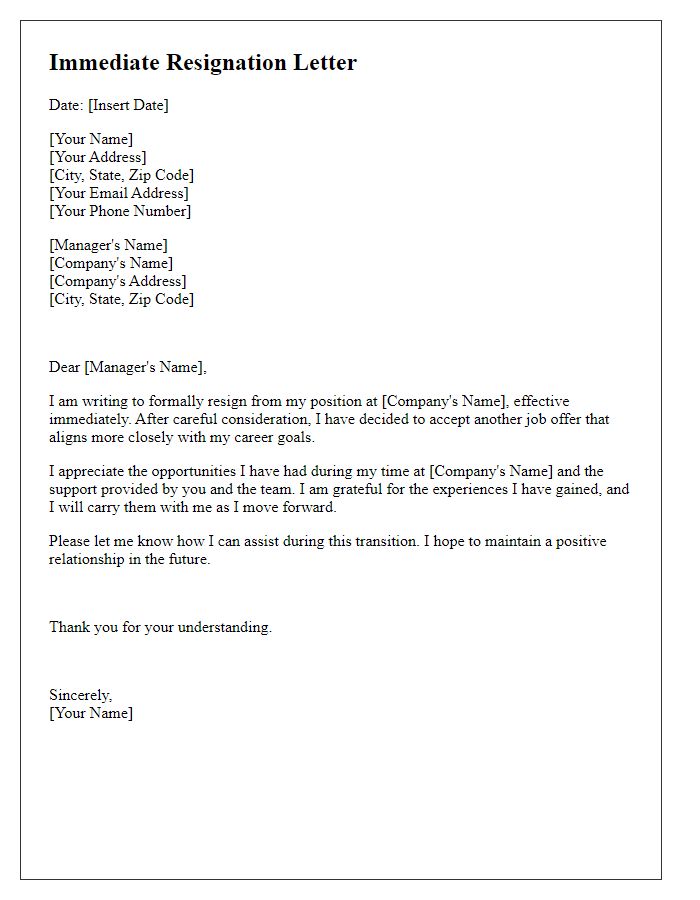If you find yourself in a situation where you need to resign immediately, crafting a clear and concise resignation letter is essential. This letter serves as a formal notification to your employer that you are leaving your position, and it helps ensure a smooth transition. While it can be a daunting task, expressing your decision politely can leave a lasting positive impression. Ready to learn how to structure your resignation letter effectively? Keep reading!

Professional tone and language
Immediate resignation from a position can be a significant decision. In such instances, it is essential to communicate effectively with your employer. A professional resignation letter should express gratitude for the opportunities provided, state the intention to resign clearly, and indicate the effective date. It is also advisable to mention availability for the transition period if applicable. Maintaining a positive tone can aid in preserving professional relationships. Example Contextual Detail: In an unexpected turn of events, a marketing manager at a leading firm in Chicago, Illinois (XYZ Corporation) decides to resign due to personal circumstances. She expresses appreciation for the professional development opportunities offered since her hiring on March 12, 2021. Her resignation letter effectively conveys her last working day as of October 15, 2023, indicating her willingness to assist during the transition phase. This approach ensures she leaves a lasting positive impression.
Clear statement of resignation
Immediate resignation can significantly impact workplace dynamics and relationships. Employees may face various reactions from managers and colleagues, especially if the departure occurs unexpectedly. Clarity in communication, specifying the effective date and the reasons, plays a crucial role in this process. It's also important to address any transitional responsibilities, as leaving without prior notice can disrupt ongoing projects and team workflows. Employers often appreciate a professional approach during this challenging moment, as it maintains mutual respect and can facilitate future references. Communication methods, such as email or official letters, should be concise yet professional to convey respect and clear intent.
Effective date of resignation
An immediate resignation can create significant challenges for both employees and employers. The effective date of resignation, particularly in situations requiring abrupt withdrawal, usually is the same day the letter is submitted. For instance, employees may cite personal emergencies or health issues necessitating immediate departure from positions such as customer service representatives or sales associates. Such decisions should consider contractual obligations, such as notice periods (often two weeks or one month), which are standard across many industries. Clear communication and adherence to company policy is vital during this process. Employees may also face consequences, including loss of benefits or references, when resigning without proper notice. In workplaces located in cities like New York or Los Angeles, where job markets can fluctuate rapidly, the impact of immediate resignations can be felt widely and long-lasting.
Expression of gratitude
A sudden resignation can express a strong sense of urgency and the need for change. A letter template for immediate resignation highlights the importance of clearly communicating intentions while maintaining professionalism. The tone remains respectful, expressing gratitude for opportunities, mentorship, and experiences gained while working at the company, regardless of the circumstances prompting the departure. It can be essential to mention acknowledgment of workplace culture and support from colleagues during the tenure, contributing positively to personal and professional growth. This ensures that the final correspondence leaves a lasting, positive impression, which may benefit future interactions within a professional network.
Offer to assist in transition
Immediate resignation from a position requires careful communication to ensure professionalism and maintain relationships. A well-crafted letter should clearly state the intent to resign, the effective date of resignation, and an offer to assist in the transition process. This demonstrates respect for the organization and appreciation for the opportunities received. It's important to remain polite and concise; emphasizing readiness to help facilitate a smooth handover of responsibilities will leave a positive impression, potentially benefiting future references or connections.













Comments